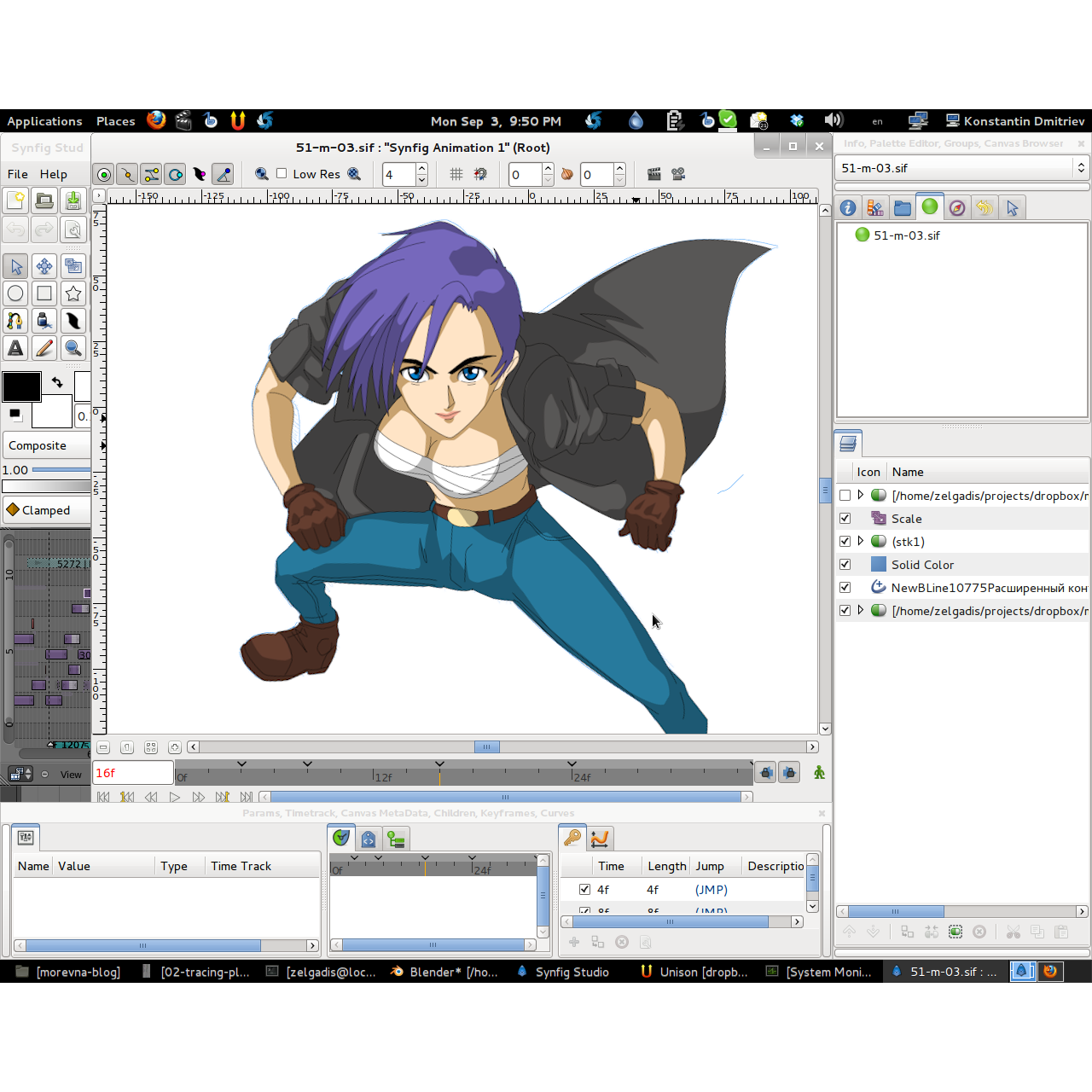

After two months of working on this in 2-4 hour sessions, I have 15 seconds of video produced. Could these things have caused the crash? Now this file crashes within a few minutes of opening it. Then the file crashed when I started working on it again. The animation worked in preview mode, with the changes I had made in non-animated mode. Then I ran the preview to see if the animation would work. The last thing I remember doing, was to change the position of my character in my background, and I also changed the size of the character’s head, while I was not in animation mode. I don’t know if it’s a coincidence that it crashed after I began animating it, since this other file would crash, even when I wasn’t using animation mode. I can't review every animation application (at least, not all at once), so the last animation suite I'll look at this year is Synfig Studio. So then I opened up a copy I had made of the basic layout and saved with a different file name, before I had tried to animate anything, That basic file worked well when i began to animate my character, and after 20 minutes or so, I had finally finished about the first 15 seconds of my animation, when that file crashed on me as well. Synfig Studio is a 'tweenless' animation system designed to speed up the animation process by using sprites and digital tweening rather than adding to the illustration workload. I downloaded Synfig 1.3 a few days ago, and it crashed within about 15 minutes, when I opened an animation that I originally built in Synfig Studio 1.2. Those are called Waypoints, and they represent times at which object's parameters, like location or color, are instructed to take on specified new values.I still have a persistent problem with Synfig crashing while I work on it. If you switch back to the Parameters Panel, and look at the Time Track Panel you will see that three orange diamonds (or green dots depending on the default interpolation) appeared on the right of the "Origin" parameter. That's why when we modified the circle's position at "1s", it stayed on the left at "2s" (as well as at "0s"). Keyframes make Synfig remember the image states at particular times. Note that you don't need to go to the last keyframe at "2s" and move your circle back to the left. Each image will later make a frame in your animation and the circle will appear to be moving.

Wondering where the animation is? Just click to an arbitrary position on the time slider: You will note that the red circle is in a new position, one that you didn't specify! So what happened? Synfig figured out what you would like to do, namely move the circle, and drew all the images between these states. There! You made your first movement, your first animation with Synfig!Ĭanvas Window, Keyframes Panel and Time Track Panel For instance, you can now jump to the first second "1s", and move the red circle to the right. You can use this to edit your image for a given moment in time. In fact, these are links just like web links: click them, and the indicator in your time slider will jump to the correct time. You might be wondering about the entries called "(JMP)". It displays "Time" which is basically the start time, "Length" which is self-explanatory, "Jump" which we'll cover next, and "Description" which is, again, self-explanatory. The Keyframes Panel is rather easy to understand. The frame markings begin at zero (0) and go up to 24, whereupon a new second is entered and the framecount returns to zero.įor example, when five whole seconds and three frames have passed, using this timeline notation would be "5s 3f". They indicate a specific point on the timeline, expressing a location in terms of seconds (s) and frames (f).īy default each second is divided into 24 frames, much like a meter on a measuring tape is divided into 100 centimeters.

The s's and f's: Understanding the Timelineīy now, you may have figured out what those mysterious "1s 10f"-type marks represent. Good to know : Synfig and time representation Change "5s" to "2s" - that will make our animation 2 seconds long. Go to the "Time" tab and make sure to edit "End Time". Give a name and description for your canvas, then click "Apply" (don't click "OK" yet - we're not quite done with the Properties dialog). The Canvas Properties Dialog will appear. Click the caret menu (between the horizontal and vertical rules, in the top left hand corner of the canvas), then select "Canvas → Properties" or select "Canvas → Properties" from the menu. A new file is created at the start automatically. In other words, you need to create three 'steps' or 'stages': Drop the realism, you get a circle moving from left to right and back. Consider a moving light like the one at the front of the Knight Rider car. It basically means to change a drawing - you just need to create the first stage and last stage of a change, and Synfig takes care of the steps in between. 4 The s's and f's: Understanding the TimelineĬreating an animation in Synfig Studio is really easy.


 0 kommentar(er)
0 kommentar(er)
